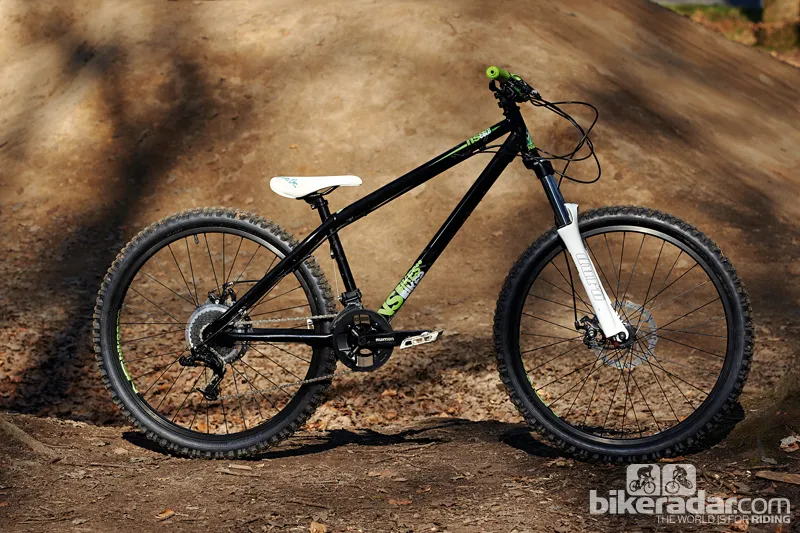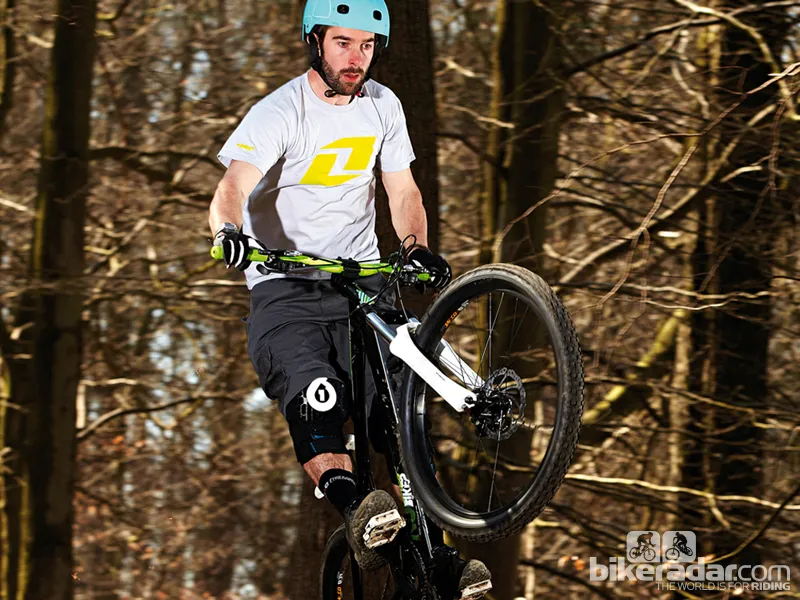Polish dirt jump bike pioneers NS have broken into the all-round hard-hitter bracket with their Core series of bikes. With rider feedback and development at the core of the company, we were expecting greatness. But while the basic Core 3 has a good frame, the low-quality, heavy spec and budget fork lets it down.
Ride & handling: Needs a few spec changes to shine
While it's firmly aimed at play riding rather than cross-country duties, we managed to get enough seatpost out of the Core 3 to be able to get pedalling, although any rider much taller than 5ft 6in was pushing the post past its limit on our size medium test bike.
Sam Pilgrim’s signature grips combined with an NS Terra bar wasn’t the most comfortable cockpit we’ve ever experienced. The bar felt as if it had no sweep, and the thick grips with minimal pattern will have limited appeal and got very slippery when wet.
The NS's ride was surprisingly harsh, even on surfaced trails. The Suntour Duro fork had problems reacting to small bumps effectively, even with the preload on both legs wound to a minimum. The spring was ideal for trail riding but the fork’s stickiness rendered it ineffective for any slight impacts.
It was disappointing on dirt jumps too, and tended to blow through its travel with little support, even with the preload wound all the way on. Small bump sensitivity isn’t an issue at the jumps though, because the fork remained pretty smooth after the initial part of the stroke. The fork seems to suffer from a jack-of-all-trades, master-of-none problem.
Throughout the testing, the Kenda Kinetic tyres were a disappointment, too. They were slow-rolling and created a lot of trail noise, as well as giving a lot of feedback and vibration at 30psi. When ragging technical singletrack, the NS came into its own. Its size allowed us to move the bike around easily, though once again the spec hampered performance.
The brake pads had a large amount of free play in the callipers, and even after an hour of fiddling, we still couldn’t get the basic mechanical callipers to feel positive and sharp. This resulted in a really spongy feel when we tried to slow down. It’s disappointing, especially as the frame could shine with a few spec changes – not least a new fork.
Frame & equipment: Bombproof but heavy
NS build their hardtails from steel because they believe it’s the best material for the purpose. It’s strong, and NS reckon it reduces vibration too. Unfortunately, there's a weight penalty with steel, and the Core is comes in at 16.8kg (37lb, without pedals).
The ‘Trimoly’ tubeset is made up of a chromoly down tube, top tube and chainstays, with simple steel tubing elsewhere. The frame of the Core 2, the next bike up in the range, is 100 percent chromoly, which makes it lighter than the Core 3. The frame has a standard 1.125in head tube, normal 135mm rear end and a 25.4mm seatpost size, which could prove a problem as 25.4mm posts aren’t easy to replace.
One of our biggest qualms with the Core is that the mech hanger isn’t replacable. Although it’s not a massive issue with a steel frame, if it’s bent a lot (which is likely, given the type of riding that the bike is designed for), it’s only going to get weaker.
Since the 3 is the entry-level bike in the Core range, the spec is nothing special, but it's all kit that should last well and take a good beating. Suntour’s Duro fork is up front with 130mm (5.1in) of travel and rebound adjustment, with the cockpit completed by an NS Quark stem and Terra bar. Tektro’s Novela mechanical disk brakes are in charge of stopping duty, with 180mm rotors front and rear.
The drivetrain is a SRAM SX-4 eight-speed setup, with dual chainrings up front to assist on the climbs. The Truvativ Ruktion crankset uses the hard-wearing Howitzer bottom bracket system. The wheelset is made up of wide Jalco rims and Joytech hubs, with the front axle being nutted while the rear is a quick-release. Kenda’s Kinetic tyres do their best to keep contact with the ground.

This article was originally published in Mountain Biking UK magazine, available on Apple Newsstand and Zinio.
